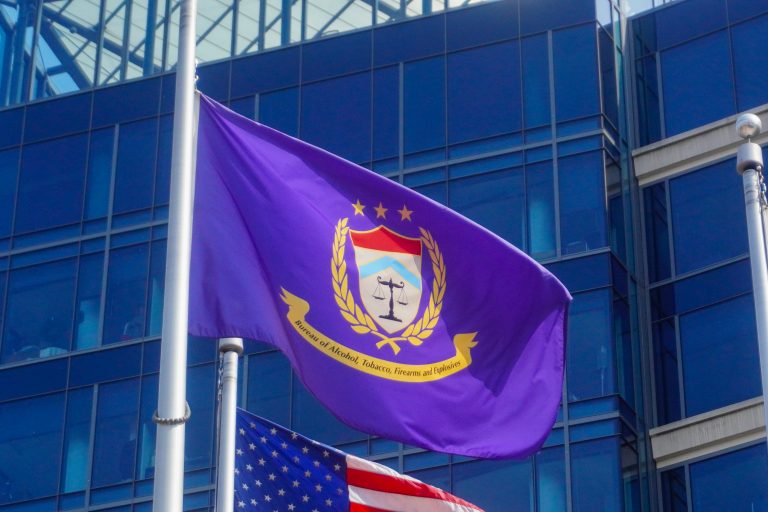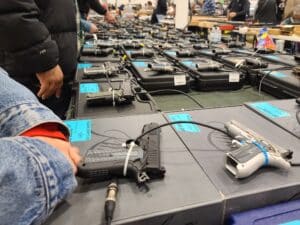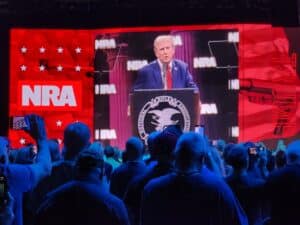It is now faster for Americans to buy sound suppressors, machine guns, and short-barreled firearms.
The ATF delivered an early Christmas present to those looking to buy items regulated under the National Firearms Act of 1934 (NFA) by offering a digital application process on Thursday. The move is part of the agency’s efforts to significantly reduce the months-long processing times for those products. The ATF said that digitizing the tax registration form and fingerprint requirement for transferring NFA items to new owners will substantially impact the overall process.
“This is an ongoing Bureau modernization and data migration project which includes the eForms system,” Erik Longnecker, a spokesperson for the agency, told The Reload. “However, one of the more notable updates is the return of the ATF eForm 4 to the system.”
The ATF has been attempting to move to a digital system for many of its required forms for several years now and has successfully reduced backlogs associated with other registration forms. In addition to offering a digitized registration form for NFA transfers, the agency also upgraded its entire digital infrastructure for handling digital registration forms of all kinds.
“The electronic filing is designed to be more efficient and accurate and will allow ATF to process the submissions more efficiently,” Longnecker said. “We anticipate there will be a similar decrease in processing times when using the eForm 4.”
The change will increase access to the highly-regulated guns and accessories that have become more popular in recent years. Suppressors, often called silencers, have seen an explosion in popularity over the past decade. The noise-muffling devices are both legal to manufacture and own in most of the country and don’t have effective alternatives on the market.
The same can’t be said for machineguns or short-barrel rifles and shotguns. The sale of newly-manufactured fully-automatic firearms to the general public was banned by federal law in 1986, which leaves only a few hundred thousand legally-registered machine guns in circulation. Short-barrel rifles and shotguns, on the other hand, have been largely supplanted by pistol versions equipped with specialized braces that aren’t designed or intended to be pressed against the shooter’s shoulder. The ATF has ruled in the past the braces fall outside the purview of the NFA, though the Biden Administration is attempting to outlaw them by walking back that exception through executive action.
Still, the reduced wait times from the new digital process could encourage gun owners to pick up more of every category of NFA item. Ian McCollum, a firearms historian and collector who runs the popular site Forgotten Weapons, said the current process utilizing physical forms mailed to the ATF can take nine months or longer to complete. He said the ATF aims to get that number down to 90 days by the end of 2022 and 30 days by the end of 2023.
“If we’re talking about a 30-day transfer, that’s still a ridiculously stupid wait time, but it’s so much better than what we’ve got now,” McCollum told The Reload. “That would be really significant.”
The ATF attempted to partially digitize the transfer process before but abandoned the project after it led to confusion.
“There were a couple problems previously,” McCollum said. “The big one was the previous attempt at it didn’t have electronic fingerprint submissions. And if you’re trying to coordinate eforms with physical fingerprint envelopes, it’s almost like what’s the point? If I have to put anything in an envelope, why not just put the whole thing in?”
McCollum said he expects this attempt to go better because both the registration form and fingerprint records can now be submitted digitally. It also eliminates the need to duplicate physical fingerprint cards every time a consumer wants to buy an NFA item.
“The other benefit here is for someone who is buying a bunch of NFA stuff, or even just a couple things, you can get your fingerprints once,” he said. “Then you just have the file, and you upload it when you need it. As opposed to, every time I want to do a transfer, I need two sets of fingerprint cards. So, if I want to buy three suppressors, I have to go get six frickin fingerprint cards. The whole point of fingerprints is they don’t change.”
He said the new process would also help eliminate typos on the registration forms, which can be time-consuming to correct. He expects the new approach to drive demand for NFA items and help make more Americans comfortable with civilian ownership of them. He said that could be a boon for gun-rights advocates who have long sought to remove suppressors from NFA regulation or repeal the law altogether.
“I think it will reduce friction in the purchasing process for NFA items,” McCollum said. “It will help to continue the trend of normalizing and popularizing them, especially short-barreled rifles and suppressors. And, practically speaking, it’ll have more impact on suppressors than anything else. Anything that makes these more normalized and more regular is a good thing for us.”
He cautioned the process would likely take some getting used to by NFA collectors, who tend to be older and less technologically literate, and the industry itself. But, he expects everyone to adapt fairly quickly since some stores already incorporate a partially-digitized process made by a company called Silencer Shop.
The ATF also cautioned anyone currently in the process of buying an NFA item from resubmitting a form they had already sent in manually.
“ATF would discourage anyone who has already submitted a paper Form 4 from withdrawing that form and then submitting an eForm 4,” Longnecker said. “That could have detrimental consequences and might result in longer delays for the customer.”
Even with the new digital option, the process for obtaining NFA items will remain significantly more onerous than obtaining a non-NFA firearm. The National Instant Criminal Background Check System (NICS) is designed to complete background checks on people who buy guns from licensed dealers instantaneously. Even in the handful of states that add additional restrictions, including mandatory waiting periods of up to 10 days and registration, on top of the federal process the process to purchase a regular handgun remains much faster than the NFA registration process. That is unlikely to change even as the ATF speeds up its operations.
UPDATE 12-23-2021 2:43 PM: This piece has been updated to correct the timeline ATF is working under. The agency aims to reduce processing time to 30 days by the end of 2023, not the end of 2022.






